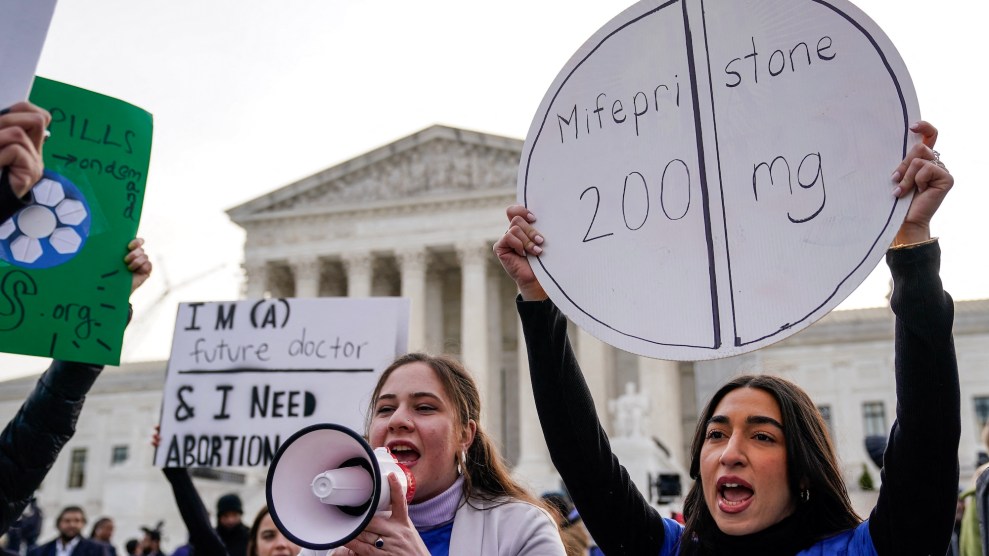
Mother Jones; Unsplash
Just weeks after the Supreme Court ended the Constitutional right to an abortion in the summer of 2022, Mylissa Farmer arrived at a hospital in Joplin, Missouri after her water broke at about 18 weeks pregnant. The doctors agreed that the fetus had no chance of survival and that she needed to end her pregnancy to avoid sepsis, hemorrhage, or even death. But instead of helping to induce labor or perform an abortion, they urged her to go to another state for care: Under Missouri’s just-triggered abortion ban, they couldn’t provide the care she needed until she was in labor or her health deteriorated and her life was in peril.
Farmer left the hospital and drove three hours to one in Kansas. Again, doctors there believed that her pregnancy needed to be terminated. But one told her the hospital’s legal team feared the consequences of providing an abortion in the state’s heated political climate. Scared, Farmer returned to the first Missouri hospital, where a NICU doctor informed her that without amniotic fluid, her uterus was constricting, breaking the fetus’ bones. “There are some fates worse than death,” the doctor told her. Because the hospital staff would not treat her, she says she felt pressured to leave and went home.
Early the next morning, nearly three days after her water broke, Farmer and her boyfriend drove 4.5 hours to Illinois, during which time she went into active labor. In the third state in three days, at an abortion clinic, she finally received an emergency surgical procedure to end her pregnancy.
“No one should be forced to undergo an experience that puts their life at risk, simply because a state politician wants that to happen,” says Alison Tanner, senior counsel at the National Women’s Law Center, which is representing Farmer in two federal complaints over the hospitals’ refusal to treat her. On Wednesday, the Supreme Court will hear Moyle v. United States, a case concerning exactly what happened to Farmer: Can state abortion bans force women to delay the inevitable end of a pregnancy, putting their health and lives on the line?
The case centers on the Emergency Medical Treatment and Labor Act, which requires hospitals to provide stabilizing emergency care to anyone who shows up requiring it for whatever reason. Shortly after the Supreme Court struck down Roe v. Wade, an Idaho law automatically went into effect making it a crime to perform an abortion. The law contained an exception to save the life of the mother—but not to protect her health. So the Biden administration sued on the grounds that withholding abortion care in a medical emergency, even if it was technically not life-threatening, remained a violation of EMTALA.
While Idaho contends that EMTALA does not require abortion care when it is needed to stabilize a patient in an emergency, it conversely argues the law creates a duty to protect the fetus equal to the duty to stabilize the pregnant person. The argument denies the reality that removing abortion access in emergencies imperils the pregnant person—something made clear by Farmer’s experience, and by other harrowing stories told by women denied emergency care to end a pregnancy.
At issue in this case is a radical idea: that states can force pregnant people in need of abortions to preserve their life and health to choose between waiting it out at grave risk or traveling across state lines as medical refugees. The high court has already signaled that it is likely to gut EMTALA’s protections for pregnant people, as it has blocked their enforcement in Idaho while the case is pending. Arriving at the court less than two years after it overturned Roe, this case presents the justices with the unvarnished reality that decision created: it has forced women into dire yet preventable health crises.
Congress passed EMTALA in 1986 in response to private hospitals’ practice of refusing to treat indigent and uninsured patients, oftentimes pushing or wheeling them to a public hospital. By delaying care, so-called patient dumpingwas killing people. So Congress required hospitals that receive Medicare funding—a critical revenue source for nearly all hospitals—to provide stabilizing care to anyone experiencing a medical emergency. A person does not have to be at death’s door to qualify for treatment under EMTALA.
In 1989, Congress amended EMTALA, adding a requirement that hospitals must try to stabilize a pregnancy even when the pregnant person’s health was not in danger. The statute uses the term “unborn child” in this context, as it does when explaining hospitals’ obligations to help women in labor deliver. But Idaho says this text creates a duty to protect the fetus at the expense of the health of the pregnant person, a position that reads fetal personhood—the idea that from conception, a fetus shares the same legal protections as people—into the law. “That is another very shocking part of Idaho’s position, that federal law would have for all of this time created a preference for the life of a fetus—even when it’s already been determined that the pregnancy is nonviable—over the life and health of the pregnant person,” says Tanner.
Beyond Farmer’s experience, other reports make clear that doctors and hospitals are withholding medically-necessary abortions in violation of patients’ right to stabilizing treatment under EMTALA. Under Idaho’s ban, women are being put on hospital planes and flown out of state. If bad weather makes that impossible, they have to be driven. “Patients suffer” in these transfers, which, as attorneys for St. Luke’s, Idaho’s largest hospital chain, wrote in siding with the Biden administration, “cause not only pain and suffering, but also more permanent effects such as organ failure, loss of reproductive organs, and other forms of disability.” Such transfers are common. In a 12-day period last October, St. Luke’s transported four patients out of state for emergency abortions, according to the Idaho Capital Sun. If before EMTALA hospitals were dumping patients at nearby hospitals on gurneys, now they are dumped via airlift.
Research shows the horrific reality of being denied a medically necessary abortion. Often, these cases arise from pre-viability preterm prelabor rupture of the membranes (PPROM), which is when the water breaks before the fetus can survive outside the womb. If this happens, chances of fetal survival are essentially zero, while delaying ending the pregnancy puts the pregnant person at risk of requiring a hysterectomy, sepsis, hemorrhage, and death. In one 2023 study by researchers at the University of California, San Francisco, a doctor in a state with an abortion ban reported the case of a woman whose water broke at 16 to 18 weeks, but was sent home without ending her pregnancy. She arrived in the emergency room two days later with severe blood infection and sepsis. She delivered the nonviable fetus, but required an additional procedure to remove the placenta. “The anesthesiologist cries on the phone when discussing the case with me—if the patient needs to be intubated, no one thinks she will make it,” the physician reported. The patient unexpectedly bled “from everywhere,” but luckily survived.
In an amicus brief filed in the Idaho case in support of the Biden administration’s interpretation of EMTALA, multiple women shared their harrowing experiences being denied abortion care until their lives were at risk. In Florida, Anya Cook was turned away from a hospital after her water broke at nearly 16 weeks pregnant. The next day, she delivered her stillborn daughter in a beauty salon bathroom, where she began to hemorrhage. She ultimately lost half the blood in her body, was put on life support, and required multiple surgeries to recover. The Biden administration determined that the hospital’s refusal to treat her violated EMTALA.
In Texas, Amanda Zurawski was likewise sent home from the hospital after her water broke at 18 weeks to await signs of sepsis. The result? She spent three days in the ICU fighting for her life, and may have lost the ability to have children, which she would have been spared had doctors ended her pregnancy days earlier. Another Texas woman told of being turned away by multiple hospitals in the state despite having an ectopic pregnancy. Ultimately, her fallopian tube ruptured and she required emergency surgery to save her life.
Not every woman will survive such a scenario. As the American College of Obstetricians and Gynecologists (ACOG) warns in an amicus brief, “four in five pregnancy-related deaths nationwide are preventable. Deterring and delaying care to Idaho patients facing obstetrical emergencies will inevitably worsen those outcomes.” And these dangerous delays are being forced on patients in situations where an overwhelming amount of the time the fetus will perish regardless. “It is torture, what they are asking pregnant people to go through in order to then be able to get the care that they need,” says Tanner.
Idaho, Texas, and other states with strict abortion bans are putting doctors in the difficult position of deciding when an emergency goes from health-threatening to life-threatening. In a future where Idaho wins, and more states short-circuit EMTALA’s protections, that decision will become even more difficult—and lie largely in the hands of hospital lawyers rather than doctors. As ACOG’s brief queries:
When is it certain she will die but for medical intervention? How many blood units does she have to lose? One? Two? Five? How fast does she have to be bleeding? Soaking through two pads an hour? Three? How low does her blood pressure need to be? 90 over 60? 80 over 50? And at what point in time does the condition of a pregnant patient with sepsis from a uterine infection deteriorate from health threatening, to life-threatening, to necessarily about to die? If the standard treatment of IV fluids does not stop her blood pressure from dropping, is her condition now life-threatening? Even if life-threatening, is the care “necessary” to prevent her death? Is it when she is unconscious, and any further treatment has become more complex and fraught with risk and further complications? And clinicians are expected to make these judgments under threat of severe criminal penalties.
Faced with the prospect of criminal investigation or charges, doctors are fleeing Idaho. The state lost 22 percent of its practicing obstetricians in the 15 months following the end of Roe. Three hospital labor and delivery units have shuttered, while two more have paused labor and delivery services. The result is a dangerous scarcity of care for pregnant women in the state, even if they don’t encounter complications.
If Idaho prevails, the Supreme Court will have created a two-tiered medical system where pregnant people can be provided a different standard of treatment. Pregnant people who come in with emergency conditions—say appendicitis, or an injury from a car accident—would be imperiled because EMTALA would not guarantee the treatment they needed if it might result in pregnancy loss. “All of a sudden, anybody who is pregnant who walks into an emergency department is a potential abortion,” says Sara Rosenbaum, an expert in health law and policy at George Washington University. “either an intentionally done abortion, or a termination of a pregnancy as a byproduct of other treatment.”
The focus on life-saving care in the Idaho case obscures how EMTALA recognized the importance of minimizing a full range of harms short of death, including organ damage and pain. Women denied emergency abortion care often must receive hysterectomies to save their lives, or lose the ability to get pregnant due to scar tissue or other complications. “Individuals who are maimed and made disabled, permanently or for years—that too should not be acceptable within American jurisprudence and within American healthcare,” says Michele Goodwin, a professor of constitutional law and global health policy at Georgetown Law.
Yet the justices who overturned Roe may welcome such a distinction and allow Idaho to privilege the unborn over the health of the living, and issue a ruling that says, as Goodwin puts it, that “you may need to save a life—but not necessarily to preserve a life.”

















